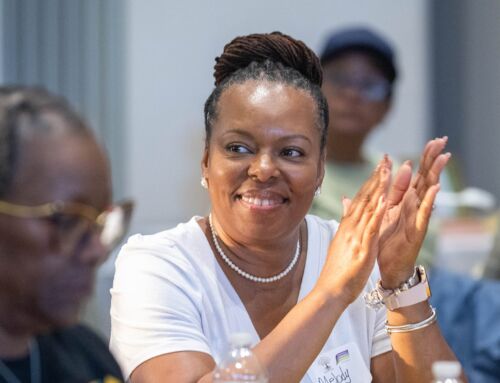
Executive Director John Simoncelli accepted the 2019 Trustee Fund Award on behalf of Litchfield-based Greenwoods Counseling Referrals at Connecticut Community Foundation’s annual meeting (right). The 27-year old organization, which provides mental health treatment for anyone who lives or works in Litchfield County, was lauded by the Trustees for teaming with the Litchfield Prevention Council and Litchfield Public Schools to improve students’ access to mental health services.
We asked John, a licensed clinical social worker and alcohol and drug counselor, what we should know about Greenwoods’ work.
What mental health needs do you see in Litchfield County communities?
It is not hyperbolic to say that we have a mental health crisis in our country, in the state and region. We see it as increases in anxiety, in suicide, and in opioid use. Some estimates show a two-to-one need in Litchfield County, so for every two people looking for services, there’s only one provider.
You say that mental health problems in Litchfield County are sometimes “hidden.” Why?
In more rural areas it’s harder for people to see, and especially in Litchfield County. It can be a very private community. There’s still a lot of stigma about going to get help. And there’s only one city in the region, Torrington, and people end up going to places where the services are at. So people end up in Torrington for mental health and addiction services but maybe they started out in Litchfield or Sharon or another rural town. So people say, “Oh, it’s a Torrington problem.” That’s not the case.
What’s keeping people from getting the mental health help they need?
By far the biggest challenge we’ve seen has been the underinsured—people who are middle class but their insurance policy is so poor that they can’t get mental health treatment. Let’s say you’ve got private insurance with a $5,000 deductible and a typical reimbursement for a therapist would be $100 per session—and you need to see them weekly. You’re never going to hit your deductible unless you have a crisis such as a hospitalization, so you’re going to be paying out of pocket $100 per week to get the therapy you need. People can’t afford that so they choose not to seek services. That’s why Greenwoods spends around $40,000 yearly subsidizing people’s care. Then, we can say to people, “Can you do 20, 40 bucks a week?” and that’s oftentimes what people can do.
What’s happening in Litchfield schools that compelled Greenwoods to act?
We’ve seen an increase in anxiety among school-aged kids over the last few years. There’s plenty of research to show that when kids reach college, they’re under more stress and suffering from more anxiety than ever before. Our idea for the school program was that if you could assess and intervene early, you can prevent more significant mental health problems from presenting later on.
Greenwoods gave Litchfield students a big lift. How?
I’m so impressed with Litchfield Public Schools in making this a priority. Julie Haggard, their director of pupil services, is a real advocate. She makes sure the faculty and staff know that if there’s a kid who seems to be in need, refer them to Greenwoods. We do the assessment, and then—based on a kid’s needs, insurance, where they live—we match them with a clinician from our network of 130 providers for continued services for as long as they need it. We were lucky enough to get a private donor and another grant from Connecticut Community Foundation to help fund the program.It’s working! How?
The power of the program is that it’s not a set of rules; we make it individualized. We have the freedom to do that. You are not a number. You’re not a client. You’re a person. We can make those extra calls—to a mother, to teachers, to grandparents. That’s the piece that is never reimbursable, which is why outside funding is so important.
And it works, too, because this is all about building trust with the school staff and having them know that they’re not alone in this, because it’s very intimidating when you have DCF, the court system or others involved—it’s a lot for the school to carry. We want to help teachers with the students’ social-emotional needs so they can focus on teaching.







